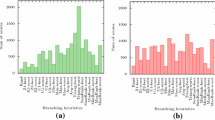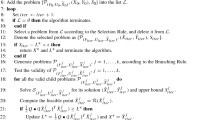Abstract
The classical 0–1 knapsack problem is considered with two objectives. Two methods of the “two–phases” type are developed to generate the set of efficient solutions. In the first phase, the set of supported efficient solutions is determined by optimizing a parameterized single-objective knapsack problem. Two versions are proposed for a second phase, determining the non-supported efficient solutions: both versions are Branch and Bound approaches, but one is “breadth first”, while the other is “depth first”. Extensive numerical experiments have been realized to compare the results of both methods.
Similar content being viewed by others
References
Czyzak, P. and Jaszkiewicz, A. (1995), Pareto Simulated annealing – a Meta-heuristic Technique for Multiple Objective Combinatorial Optimization, Technical report, Institute of Computing Science, Poznan University of Technology. Submitted for publication.
Dyer, R., Foreman, E. and Mustafa, M. (1988), Decision support for media selection, Technical report, Georges Washington University. Presented at the Third International Summer School on MCDM held at Estoril (Portugal).
Ferreira, H. and Pardalos, P. (1996), Solving Combinatorial Optimization Problems in Parallel, Vol. 1054 of Lecture notes in computer science, Springer-Verlag.
Martello, S. and Toth, P. (1990), Knapsack Problems: Algorithm and Computer Implementation, Wiley.
Rosenblatt, M. and Sinuany-Stern, Z. (1989), Generating the discrete efficient frontier to the capital budgeting problem, Operations Research 37(3), 384–394.
Ulungu, E. and Teghem, J. (1994), Multi-objective combinatorial optimization: A survey, Journal of Multi-Criteria Decision Analysis 3(2), 83–104.
Ulungu, E. and Teghem, J. (1995), The two-phases method: An efficient procedure to solve biobjective combinatorial optimization problems, Foundations of Computing and Decision Sciences 20(2), 149–165.
Ulungu, E. and Teghem, J. (1997), Solving multi-objective knapsack problems by a branch-and-bound procedure in Multicriteria Analysis, J. N. Climaco (ed.), 269–278 Springer-Verlag.
Ulungu, E., Teghem, J. and Fortemps, Ph. (1995), Heuristics for multi-objective combinatorial optimization by simulated annealing, in Multiple Criteria Decision Making: Theory and Application. Proceedings of the 6th National Conference on MCDM, Beijing (China).
Author information
Authors and Affiliations
Rights and permissions
About this article
Cite this article
Visée, M., Teghem, J., Pirlot, M. et al. Two-phases Method and Branch and Bound Procedures to Solve the Bi–objective Knapsack Problem. Journal of Global Optimization 12, 139–155 (1998). https://doi.org/10.1023/A:1008258310679
Issue Date:
DOI: https://doi.org/10.1023/A:1008258310679




